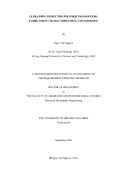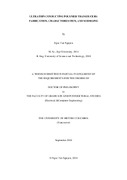
Please use this identifier to cite or link to this item:
http://thuvienso.dut.udn.vn/handle/DUT/1927| DC Field | Value | Language |
|---|---|---|
| dc.contributor.author | Nguyen, Ngoc Tan | |
| dc.date.accessioned | 2024-11-06T01:45:21Z | - |
| dc.date.available | 2024-11-06T01:45:21Z | - |
| dc.date.issued | 2018 | |
| dc.identifier.uri | http://thuvienso.dut.udn.vn/handle/DUT/1927 | - |
| dc.description | Doctoral thesis. Major: Electrical and computer engineering; 182 pages | vi |
| dc.description.abstract | Recently, ultrathin poly (3,4-ethylenedioxythiophene) (PEDOT) – based ionic actuators have overcome some initial obstacles to increase the potential for applications in microfabricated devices. While microfabrication processing of trilayer actuators that involve no manual handling has been demonstrated, their mechanical performances remain limited for practical applications. The goal of this thesis is to optimize the transducers in thin films fabrication by micro technologies, fully characterize the electrochemomechanical properties of the resulting trilayers, and develop a model to simulate their bidirectional electromechanical ability (actuation and sensing). At first, ultrathin PEDOT-based trilayer actuators are fabricated via the vapor phase polymerization of 3,4-ethylenedioxythiophene combining with the layer by layer synthesis process. This constitutes the first full characterization of ionic PEDOT-based microactuators operating in air of such a small thickness (17 µm) having bending deformation and output force generation of 1% and 12 µN respectively. Secondly, electrical, electrochemical and mechanical properties of the resulting microactuators have been thoroughly studied. Non-linear characterization was extended to volumetric capacitance dependence on voltage window. Damping coefficient was characterized for the first time. Thirdly, a nonlinear multi-physics model was proposed as a method of simulating actuator and sensor responses in trilayers, represented using a Bond Graph formalism, and was able to implement all of the characterized parameters. The concordance between the simulations and the measurements confirmed the accuracy of the model in predicting the non-linear dynamic electrochemical and mechanical response of the actuators. In addition, the information extracted from the model also provided an insight into the critical parameters of the actuators and how they affect the actuator efficiency, as well as the energy distribution. These are the key parameters for designing, optimizing, and controlling the actuation behavior of a trilayer actuator. Finally, a nouveau bidirectional electromechanical linear model was introduced to simulate the sensing ability of the trilayer transducer. The simulation coherently matches the experimental results in both frequency and time domains of a sinusoidal input displacement. The resulting actuators and the proposed models are promising for designing, optimizing, and controlling of the future soft microsystem devices where the use of polymer actuators should be essential. | vi |
| dc.language.iso | en | vi |
| dc.publisher | L’UNIVERSITÉ DE POLYTECHNIQUE DES HAUTS-DE-FRANCE ET L’UNIVERSITÉ DE COLOMBIE BRITANNIQUE | vi |
| dc.subject | Electroactive polymer | vi |
| dc.subject | Conducting polymer transducers | vi |
| dc.subject | Interpenetrating networks | vi |
| dc.subject | Non-linear characterization | vi |
| dc.subject | Non-linear dynamic modeling | vi |
| dc.subject | Bond Graph formalism. | vi |
| dc.title | Ultrathin conducting polymer transducers: Fabrication, characterization, and modeling | vi |
| dc.type | Luận án | vi |
| item.openairetype | Luận án | - |
| item.languageiso639-1 | en | - |
| item.openairecristype | http://purl.org/coar/resource_type/c_18cf | - |
| item.grantfulltext | restricted | - |
| item.fulltext | Có toàn văn | - |
| item.cerifentitytype | Publications | - |
| Appears in Collections: | LA.Kỹ thuật điện | |
Files in This Item:
| File | Description | Size | Format | Existing users please Login |
|---|---|---|---|---|
| NguyenNgocTan.TT.pdf | Abstracts & Table of Contents | 1 MB | Adobe PDF |  |
| NguyenNgocTan.TV.PDF | Fulltext | 13.04 MB | Adobe PDF |  |
CORE Recommender
Google ScholarTM
Check
Items in DSpace are protected by copyright, with all rights reserved, unless otherwise indicated.